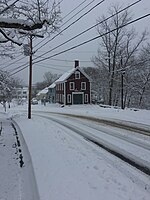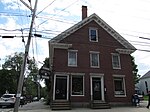Hose No. 2
1889 establishments in MaineBuildings and structures in Yarmouth, MaineDefunct fire stations in MaineFire stations completed in 1889

Hose No. 2 is a former fire station in the Lower Falls area of Yarmouth, Maine, United States. Built around 1889, seven years before the town's first fire hydrants were installed, it stands in a wedge-shaped plot of land separating Main Street and Marina Road at what was formerly known as Staples Hill (named for Bethiah Staples, who lived at nearby 63 Main Street). By 1901, the town had "two hose companies of fifteen men each" and a hook and ladder company of ten men. A system of fire alarms, consisting of eight boxes, were in the process of being installed.
Excerpt from the Wikipedia article Hose No. 2 (License: CC BY-SA 3.0, Authors, Images).Hose No. 2
Main Street,
Geographical coordinates (GPS) Address Nearby Places Show on map
Geographical coordinates (GPS)
| Latitude | Longitude |
|---|---|
| N 43.797837937 ° | E -70.18044885 ° |
Address
Main Street 50
04096
Maine, United States
Open on Google Maps








